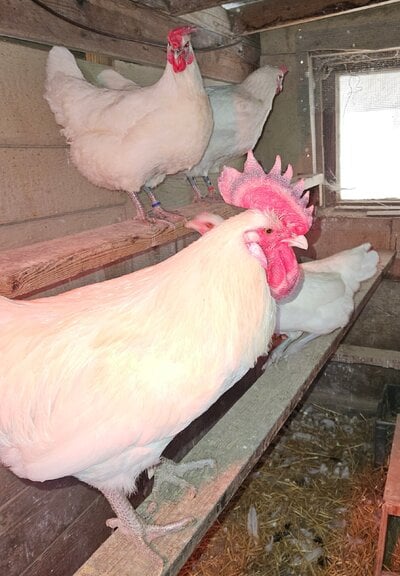PonderingKiwi
Chirping
- Mar 19, 2023
- 65
- 100
- 88
Our coop is a shed that was converted into a dog run. We converted it into a coop with a chicken run. Pretty convenient tbh. We insulated it before it got too cold and it’s been pretty good all winter.. until now. Sadly.. we had a casualty today. My husband went outside to check on everyone and found a lady frozen solid. No idea how she died.. we assumed she froze to death because our rooster has big swollen frostbitten wattles and frostbite on his comb. He also had ice on his back somehow. Super heartbreaking state of affairs. We borrowed a couple dog crates and brought everyone inside. Which is loud and quite stinky.. but I love my ladies.. I’m crushed we lost one. We put two heating lamps out there when we saw it was going to get into the -20s.. but they can’t keep up with the cold apparently. So we need something that can. The coop is 10x10x10ish. Does anyone have any ideas for what can heat that big of an area while also not setting our coop on fire? We’ve been scouring the internet, but everything that look like they definitely would help so expensive.. it’d be really crappy to buy/order something just for it to not work any better than the lamps did.
And if anyone knows anything to help Ronald.. he’s warm now. We *carefully* put some Vaseline on his comb.. and all I found online was that it could help so we also gave him a baby aspirin.. I know it’s gotta hurt and my nonmedically trained brain thought “aspirin is a blood thinner for people.. maybe it’ll help increase blood flow to the affected area and help bring it back”. Idk if that’s how it works.. but if nothing else, I know his face hurts. Tearing up thinking about it tbh… he’s such a good man to his ladies, he deserves better than this. They all do
 a couple of the hens with bigger combs have some frostbitten tips too.. and one lady has a little pointy piece that turned white? Which I think is unrelated, but looks odd. A couple ladies were also sneezing a lot. We did our best to separate them (hard with so little space to work with) and smeared some vetrx on their noses/combs.
a couple of the hens with bigger combs have some frostbitten tips too.. and one lady has a little pointy piece that turned white? Which I think is unrelated, but looks odd. A couple ladies were also sneezing a lot. We did our best to separate them (hard with so little space to work with) and smeared some vetrx on their noses/combs.
PS. It wasn’t our naked neck lady, Edna, if anyone’s kept up with our naked chicken saga. We had already brought her inside thinking she’d be the most susceptible. Glad we did.
Side question: one of their poops had a big long whiteish worm looking thing in it. Google tells me it’s roundworm. We’re gonna buy safeguard tomorrow.. my question is, does that give them awful diarrhea? Should we not treat them for it with them indoors or would being able to clean their bedding once a day help with this? I just don’t want a bunch of explosive diarrhea chickens stuffed together in a dog crate in the house stinky.
stinky.
And if anyone knows anything to help Ronald.. he’s warm now. We *carefully* put some Vaseline on his comb.. and all I found online was that it could help so we also gave him a baby aspirin.. I know it’s gotta hurt and my nonmedically trained brain thought “aspirin is a blood thinner for people.. maybe it’ll help increase blood flow to the affected area and help bring it back”. Idk if that’s how it works.. but if nothing else, I know his face hurts. Tearing up thinking about it tbh… he’s such a good man to his ladies, he deserves better than this. They all do
PS. It wasn’t our naked neck lady, Edna, if anyone’s kept up with our naked chicken saga. We had already brought her inside thinking she’d be the most susceptible. Glad we did.
Side question: one of their poops had a big long whiteish worm looking thing in it. Google tells me it’s roundworm. We’re gonna buy safeguard tomorrow.. my question is, does that give them awful diarrhea? Should we not treat them for it with them indoors or would being able to clean their bedding once a day help with this? I just don’t want a bunch of explosive diarrhea chickens stuffed together in a dog crate in the house
Last edited:






 because all four of my roosters have frostbite. One is so severe I believe I may have to cull him; It's down halfway into the meaty part of his comb.
because all four of my roosters have frostbite. One is so severe I believe I may have to cull him; It's down halfway into the meaty part of his comb.